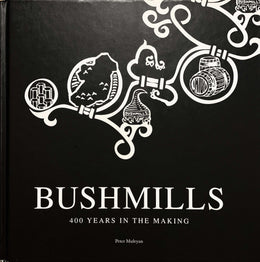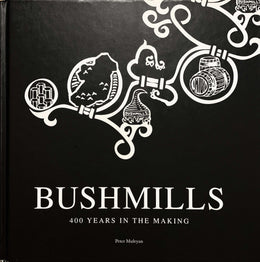
The wooden wash backs (fermenting vessels) where the wort is converted into a strong beer (wash), 1926
Following the death of his father, Wilson Boyd took over the reins at Old Bushmills. His brother Austin assisted him and together they would guide the distillery through the bleakest, leanest years of its existence. It is pretty clear that the brothers Boyd did not inherit the gleaming distillery we know today; in fact until just before his death, their father had let the place pretty much rot. A true picture of the mess they had inherited can be seen through the journal of their recently appointed Manager, James Watt Morrison.
Morrison, a taciturn Scot who had trained at DCL Mortlach distillery, was appointed in 1931. He recalls the catalogue of disasters that greeted him. The boiler "was really ancient," the floor of the Mash Tun was "in a terrible state," and the Wash Backs were so full of holes they "could not have kept in small potatoes".
Production capacity was nothing like the 6,000 gallons a week boasted of only five years previously, it was actually just short of 10,000 gallons a year. The reason that Samuel Wilson Boyd had employed the Scot quickly became clear. The distillery had run out of whiskey, Morrison discovered.
"Stocks of matured spirit amounted to a few hundred casks most of it going back to 1914."

Morrison's recollections are a remarkable insight into how Old Bushmills distillery, which on the surface at least was doing well, was in reality so close to total collapse. As he bluntly puts it: "Bushmills when I took over was not capable of operating."
The Boyds wanted to get the distillery back up and running as quickly as possible. With very little stock remaining, a very ambitious target of 30,000 gallons was set for the first year, so Morrison got to work. He bought barley direct from local farmers and dried it on the Bushmills kiln. Then the Wash Backs were mended and a Belfast shipyard copper worker came from Belfast to fix the stills. But it is clear there had been no investment for years. No sooner had one problem been fixed than another cropped up. The list of problems goes on and on, from over-worked staff to the corn mill:
"The miller, Jim Waters told me that it very often exploded in the elevator and this I could readily believe, there was no explosion vents and the elevator was going the wrong way. The elevator had had several such accidents so that the tower was nearly two feet off plumb."
Despite everything, in mid-January 1932 the team at Old Bushmills were ready to fire up the old pot stills. Morrison's tenacity had paid off, but he would need all the resolve he could muster as the initial run of spirit was, in his own words "vile". Wilson Boyd was present for the distillation and was told in no uncertain terms that the spirit was unusable. But Morrison had a solution.
"I outlined what was in my head," he wrote, "and asked his permission to put it into practice. I immediately obtained this and so was born a triple type of pot still, not in use anywhere else."
For all the detail in Morrison's journal, he doesn't let emotion get in the way of practical information, so there no knowing what was going through his head when three weeks later the stills were fired for a second time. He simply records "we were now producing a very nice spirit". He does however allow himself the luxury of putting the statement in bold type. But we can gather from Wilson Boyd's reaction to the new make spirit, that the Scot was being self-deprecating. Boyd had been so impressed with the spirit that he took samples to Scotland, where they received an enthusiastic response.
Morrison was offered a pay rise and asked if he could increase production. He recalls that after discussing matters with Wilson Boyd "the quality of the present standard was not expected by himself or his brothers".
We can tell from Morrison's memoirs that the Boyd brothers knew little about the practical day-to-day running of a distillery and at every turn they sought and took advice from colleagues in Scotland. But it is clear they knew Old Bushmills was a distillery living on past glories, that they needed to secured its future and set it on track for future glory. But along with the money, the Boyd brothers had the will to make things happen. Within two seasons the distillery workforce had increased to eleven, while output had gone up tenfold to some 100,000 gallons a year.
It takes three years to turn new make spirit into Irish whiskey. However, this is a bare minimum, a legal requirement, and whiskey is not bottled at three years and a day. More often than not it takes five to seven years for a whiskey to have matured enough to be blended. A single malt from Bushmills though can be a decade or two old before it is ready to be enjoyed. By the mid-1930s, although Old Bushmills was again making whiskey, none of it was saleable. With their warehouses now emptier than ever, Wilson Boyd bought up the stock of the well-respected, but mothballed, Comber distillery as well as some mature grain whiskey from the closed Belfast plant Avoniel. These whiskies, along with what little Old Bushmills whiskey remained were blended and sold under a variety of Boyd-owned labels. Without this cash flow the company couldn't have survived. Maturing whiskey for a decade or more plays havoc with cash flow: what other business produces something, then locks it up for a decade before selling it? It takes very deep pockets to start up a distillery, and in essence that is what Wilson Boyd was doing.
Despite the poor condition of the distillery and the collapse of the domestic whiskey market, Old Bushmills was buzzing with activity. The Boyds were in this for the long haul. They were investing heavily in production and were cannily looking around to buy more mature whiskey. What they found hit the headlines of the Belfast News Letter on 7th September 1933. 'Belfast Firm's Purchase' ran the story of how the Coleraine distillery had just been bought by Messrs Boyd and Co. Whatever about it being a "local transaction", the writer clearly saw the commercial reasons for Wilson Boyd's interest.
"Recent events in the United States in regard to the voting on the liquor question have been closely followed by interests in Europe likely to be affected by the result."
On the same day The New York Times reported that "the Coleraine company, more than a decade old, has enormous stocks of bonded liquor". Indeed it had, and that paper added another interesting piece of information; Wilson Boyd had "recently returned from New York."
On 5th December 1933 President Franklin D. Roosevelt repealed the Volstead Act, bringing an end to Prohibition. After his broadcast to the nation he allegedly said, "I think that this would be a good time to have a beer."
It turned out that Boyd the canny businessman had pulled off quite a coup, so it is not surprising that he was reported to be "highly pleased" with his purchase of Coleraine. Following the repeal of Prohibition, the Irish whiskey industry was in no shape to cash in on the reopening of this major export market. Wilson Boyd on the other hand had, in his own words "huge stocks of whiskey, the up-to-date plant, the goodwill and the trade connection of such an old concern".
Boyd had returned from the States with orders in his back pocket. On 31st November 1933 the first shipment of whiskey left Belfast for New York, in anticipation of the repeal of Prohibition. Wilson Boyd spoke to the Belfast Telegraph.
"We are delighted to get the order. The whiskey is to be sent direct to New York and all the necessary licences are in our possession for the shipment. It is the only order, so far as I can find out, to be completed under official permit. We regard it as a great compliment to our firm and it is some recognition of our efforts to secure orders in America. We hope the order is the forerunner of many others."
Indeed it was just the first of a wave of orders to be wired across the Atlantic.
"We have been preparing for America to go wet for more than ten years!" he said at the time.
Boyd's visit to the States had paid off big time, and his vision was richly rewarded. Just twelve days later the Telegraph reported that yet another shipment has been ordered.
"It is probably the biggest shipment of bottled whiskey that has ever left an Irish port. The bulk of it is for Chicago."
Within the week the Customs in Belfast port were reported to be working overtime to get the shipment out by Christmas. Boyd had pulled it off: not only had he secured the distillery's future, but in doing so he had captured the vital North American market.

One of the maturation warehouses, filled with Sherry butts, 1926. Note the distilled date (1905) on one exceptionally old cask in the foreground.


Inside the still house, 1926. On the left next to the spirit safe, note the two fire buckets. One of the riveted wash stills on the right has a flat top accommodating the drive shaft for a rummager, preventing solids in the wash from sticking to the bottom of the still.


American advertisements from the 1930s. After the War, Bushmills flourished in the US market.
Written by Peter Mulryan
The text is an excerpt from "Bushmills: 400 Years in the Making" (pp. 83 - 91), written by Peter Mulryan, published 2008 by Appletree Press Ltd.







